Into The Wild: Working Nature Into Singapore's Urban Spaces
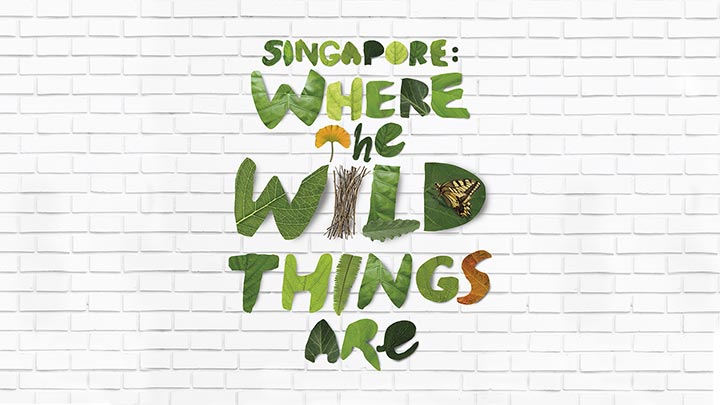
In 1984, Harvard evolutionary biologist Edward O. Wilson observed that people crowded at national parks to experience natural landscapes and travelled long distances to stroll along the seashore, “for reasons they can’t put into words”. To explain such behaviours, he popularised the term “biophilia”, for the innate emotional affiliation of human beings to the natural world. Where does this connection with greenery come from? Why do human beings, when removed from nature, tend to seek out its elements nevertheless?
Nature and well-being
Biophilia, Yale University’s Professor Emeritus of Social Ecology Stephen Kellert told Challenge, is a “consequence of our species’ evolutionary history, where for most of our biological development we adapted to largely natural, not artificial, forces and stimuli”.
Still, although biophilia is embedded in our genes, without sufficient contact with nature, this inherent tendency will atrophy — in much the same way our muscles weaken when little used.
And younger people in urbanised areas, Professor Kellert observed, are “less likely to appreciate the full breadth and diversity of the natural environment given their more limited contact with nature”.
A deficit of nature could have negative physical and psychological effects.
According to findings published in the National Childhood Report by UK non-government organisation, National Trust, rates of obesity, self-harm and mental health disorders diagnosed in children in the UK have climbed significantly since the 1970s. This has been attributed to “in-door parenting” and an increased dependence on gadgets to focus children’s attention, rather than engaging in unstructured play outdoors.
Meanwhile, researchers in the US have found that environment-based education — getting children to learn outside the classroom, in nature and the community — has dramatically improved test scores and helped children develop skills in problem-solving, critical thinking and decision-making.
In Japan, experiments to test the therapeutic effects of nature in lowering blood sugar levels were conducted among non-insulin-dependent diabetics over the course of six years. The subjects exercised on indoor treadmills and walked the same distance in a forest. While the indoor exercise reduced blood glucose levels by 21.2%, the outdoor activity decreased blood glucose by an impressive 39.7%.
All these suggest that there are health benefits in engaging with nature, and the evidence continues to grow. Other documented benefits include reduced stress, lower blood pressure, improved cognitive functions, enhanced mental stamina and focus, decreased violence and criminal activity, and increased learning rates.
Biophilic design
How can a land-scarce nation like Singapore, however, enjoy the benefits of nature while balancing the need for urban development?

One approach is through biophilic design, or designing with nature, which involves the creative incorporation of natural elements into homes, schools and workplaces, so that people are constantly in touch with nature.
Google is perhaps the leading example of companies that are experimenting with biophilic design in their workspaces. By infusing natural elements such as daylight, water features and forms of disorder such as curved pathways into the design of its offices, Google seeks to use the aspects of nature that trigger positive biological responses to improve staff well-being, focus and productivity.
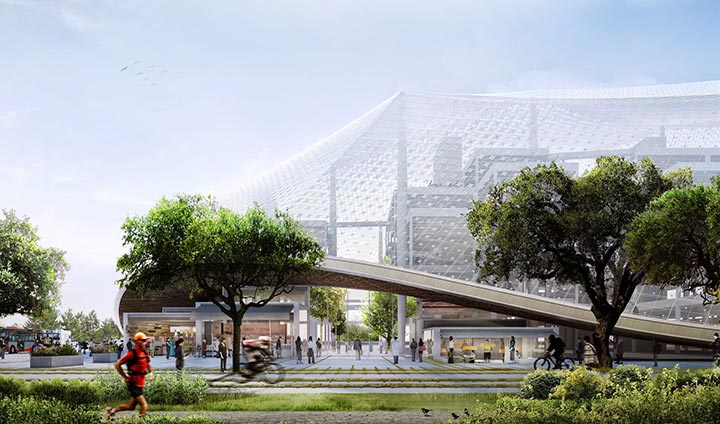
In 2015, Singapore’s Centre for Liveable Cities (CLC) organised the first “Biophilia and the Future of Sustainable Cities” symposium to explore how biophilic design can be incorporated into the built environment, so that nature’s restorative effects can boost the quality of urban life. Some 300 public officers, academics and industry partners joined in the discussions.
Following the symposium, the National Parks Board (NParks) is producing a set of guidelines, with input from international experts, for nurturing biophilia and incorporating aspects of nature into buildings and other physical structures in Singapore.
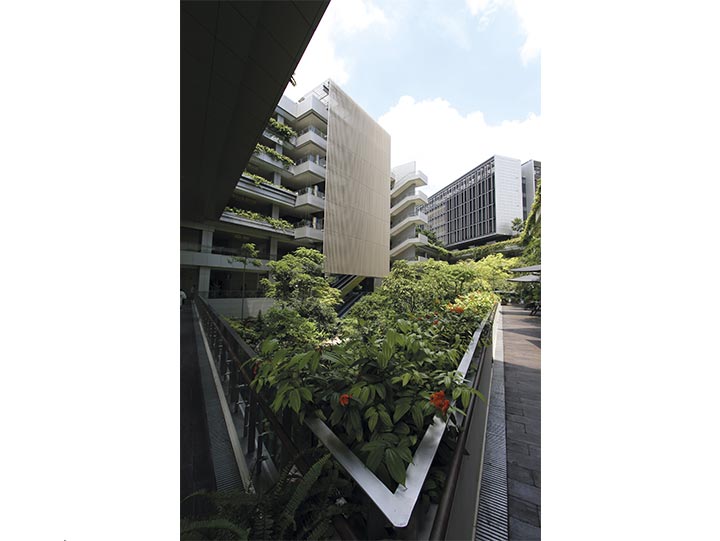
The Khoo Teck Puat Hospital (KTPH) is one of the first buildings here to use biophilic design. Natural light is enhanced within its internal layout, and the landscape of the adjacent Yishun reservoir offers scenery for its east-facing wards. Other wards have palm trees in planters outside full-length windows, granting each ward a verdant view. The result: a building that is a vision of green from the inside as well as the outside.
Mr Liak Teng Lit, Group Chief Executive Officer at Alexandra Health, which manages KTPH, told Challenge that when the hospital was being conceived, the planners did not want residents in the neighbourhood “to be confronted with the sight of a big imposing building”. The lush greenery softens the appearance of the hospital and adds value to the space, he said.
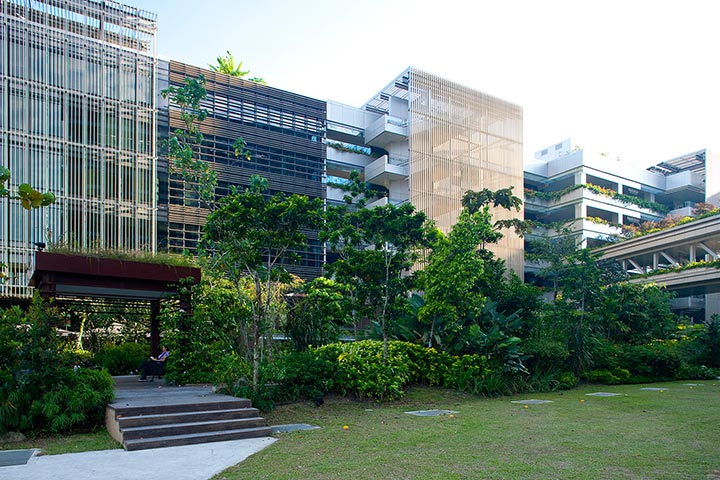
The hospital is also meant to be a space for the community, where patients, staff and nearby residents can interact and bond over gardening, wildlife watching and exercise. Its open concept allows for its physical boundaries to merge seamlessly with the surrounding recreational areas. Benches provide a place to rest under the shade of trees.
“The biggest moment for me was when I saw students studying in the hospital gardens under the canopy of the trees,” said Mr Liak.
The rise of biophilic cities
The concept of a biophilic city takes biophilic design to a larger scale. In his book Biophilic Cities, Professor Tim Beatley, who teaches Sustainable Communities at the University of Virginia, explains that city planners have a unique opportunity and obligation to take biophilic design beyond conventional parks and buildings-centred green design, to “redefine the very essence of cities as places of wild and restorative nature”. Singapore is one of the partner cities within the Biophilic Cities Network founded by Professor Beatley, who also attended the symposium.
As part of Singapore’s efforts to develop a liveable and sustainable city, several public agencies have embraced the biophilic ethos in their planning.
Elements of Biophilic Design
How does your office space fare?
- Views of nature or that mimic nature
- Large windows that let in daylight
- A sense of open space
- Natural materials such as wood grain
- Potted plants or water features
The Housing & Development Board (HDB) has a Biophilic Town Framework that aims to understand how greenery can enhance the health and well-being of HDB residents. Its plan to develop housing estates into “sustainable, smart and biophilic towns” will draw upon existing works in Punggol Eco-Town and a Greenprint pilot project in Yuhua estate.
The design phase of new HDB towns will use computer models to understand the flow of wind and the effect of light and shade, as well as the impact of noise across its towns. Biophilic elements can then be added to enhance the quality of living spaces.

The Urban Redevelopment Authority also has guidelines for replacing greenery lost on the ground for new developments in the downtown core and central business district, as well as parts of Kallang, Jurong and more.
This means that new office buildings in those areas, for example, must have ground- or mid-level green spaces that altogether equal the size of the development site. Going beyond removable potted plants, at least 40% of the green space must be permanent “softscape” planting, with trees or shrubs highly encouraged. The guidelines call for such spaces to be accessible to the building occupants and the public, and, if not uncovered or exposed to the sky, to have open sides and be naturally ventilated.
![[article title] reprieve on a green roof](/images/default-source/challenge-library/ideas/deep-dive/into-the-wild-working-nature-into-singapore's-urban-spaces/reprive-on-a-green-roof.jpg)
Reprieve on a Green Roof
NParks’ Skyrise Greenery Incentive Scheme promotes greenery on the walls and roofs of buildings. On roofs, “horizontal greenery” can be in the form of decorative rooftop gardens, open to visitors, or more extensive “green roofs” that are low maintenance. Under this scheme, NParks funds up to 50% of the installation costs of rooftop and vertical greenery. The scheme has contributed to the greening of more than 110 buildings since 2009. Perhaps the next time you need a work break, skip the pantry snacking or a nap at your desk for a walk in a rooftop garden. If your office building lacks one, find the nearest spot of green with the Skyrise Greenery Trail Maps.
At NParks, its Nature Conservation Masterplan focuses on the systematic efforts in strengthening biodiversity conservation. In an article for the CLC’s Urban Solutions (Issue 8), the agency described how its planners are tasked with safeguarding and enhancing biodiversity in urban areas as well as wilderness ones, and collaborating with other public agencies, organisations and individuals to do so.
Within urban areas, biodiversity can be enhanced by planting native plants in gardens to attract native fauna. Some of these efforts can be led by ground-up initiatives, such as at the butterfly garden in Tampines-Changkat.
What began as an informal experiment to attract butterflies with native plants got Tampines residents curious about the different types of plants that butterflies and their larvae exploit for food. They learnt to embrace that, “if we love butterflies, we must appreciate the caterpillar,” said butterfly enthusiast and architect Mr Khew Sin Khoon. Speaking at the symposium, he noted that Singaporeans tend to cringe at the thought of critters in the landscape, even if they embrace “natural” design.
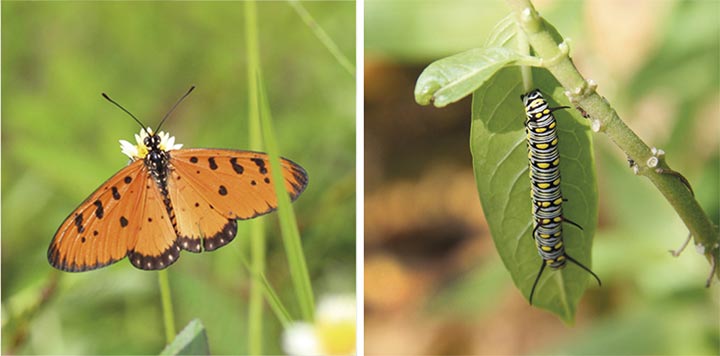
With this in mind, the residents, with Mr Khew’s supervision, planted layers of shrubs to cater for both the larval development and butterfly growth. The butterfly garden is as much a space for recreation as it is for education, which is the very nature of an unstructured learning environment. “Nature is sometimes messy and unpredictable,” said Mr Khew.
For those seeking to ease urbanites into the wilder side of things, he recommended: “We should create in our designs a layered effect: start with a safe environment, layer it with a wilder area, and then have an absolutely wild area. Temper that expectation and along the way, have education and engagement, for both the young and the older generation who have lost touch with nature in the urban built environment.”
Although the wilderness is not explicitly a part of the urban environment, by virtue of its existing adjacent to urban spaces, they share an inherent and intimate relationship.
Thoughtful planning and management is required to ensure that the urban spaces and wild ecosystems can coexist in tandem. For example, suitable buffer zones between nature reserves and urban developments can prevent conflict between people and wildlife. This is a larger scale of Mr Khew’s “layered effect”.
“We can live harmoniously with wildlife if we understand their behaviour and respect their territory,” said Dr Lena Chan, Director of the National Biodiversity Centre at NParks.
Easing into the wild
Surely but slowly, Singapore’s biophilic efforts are moving away from carefully manicured gardens to “wilder”, more natural looking streetscapes, gardens and nature ways.
The mangroves lining Sungei Api Api were a deliberate effort by NParks to re-establish the original mangrove habitat after land reclamation at Pasir Ris. The mangrove restoration, which also helps to deepen the water channel, was part of local biochemist Dr Jean Yong’s “dream” to actively replant mangrove trees, especially species that are endangered.
Dr Yong, Associate Professor at the Singapore University of Technology and Design, observed that despite extensive reclamation, “pockets of surprisingly good mangrove and seashore vegetation remain”. With strategic management and planning, he noted, these pockets could attract more native flora and fauna.
![[article title] [article title]](/images/default-source/challenge-library/ideas/deep-dive/into-the-wild-working-nature-into-singapore's-urban-spaces/jurong-eco-garden.jpg) Photo courtesy of Koh Weng Wong.
Photo courtesy of Koh Weng Wong.
Jurong Eco-Garden
Jurong Eco-Garden is a 5-hectare park (about the size of seven football fields), designed to be a place of respite within JTC’s CleanTech Park, an industrial business park. The Eco-Garden’s design includes a stream ravine and a man-made freshwater swamp. It is kept open for the working community in the business park and the residents who live nearby — to expand the sense of ownership by the community. Schools and grassroots organisations visit to participate in biodiversity-related activities to learn about native biodiversity.
The native trees, combined with the new fruit and nectar-producing plants, now sustain a diverse range of wildlife, with over 139 species of flora and fauna recorded so far, of which seven are considered species of conservation interest. The vulnerable Common Birdwing and endangered Straw-headed Bulbul have also been frequently spotted in the Garden.
Mr Leow Thiam Seng, Director of JTC’s Aerospace, Marine & CleanTech Cluster, recalled that when a Violet Cuckoo (pictured above), an endangered bird, was spotted one day, the word quickly spread among interest groups, and at least 30 nature photographers turned up the next day. “People were sharing the photographs with other visitors, and even sharing photography techniques. It’s interesting to see how nature can bring people closer to one another.”
“Probably not many ordinary people who drive and walk past the wild mangroves at Sungei Api Api realise just how special they are,” wrote influential environmental activist Ria Tan on her WildSingapore blog.
Biophilic design in a city can also help shift the attitudes and perspectives of city dwellers towards wildlife.
“In many European and American cities, people marvel at bats in flight, revel at the sight of foxes in their backyards, and rejoice when they are woken up by the morning choruses of the birds. Singaporeans are beginning to appreciate and enjoy the presence of wildlife in their midst,” said Dr Chan.
The Active, Beautiful and Clean Waters Programme launched in 2006 by PUB, Singapore’s national water agency, sought to “transform the country’s water bodies beyond their functions of drainage and water supply into beautiful and clean rivers and lakes with new spaces for community bonding and recreation”.
PUB and NParks engaged designers, engineers, bioengineers and horticulturalists to reimagine and implement ideas and strategies that would convert a concrete canal in Bishan Park into a space for wildlife to establish itself, and where people could explore the waters safely.
Now known as Bishan-Ang Mo Kio Park, this space has become one of the best locations in Singapore to observe wild otters.
A biophilic Lion City
Such re-emergence of wildlife, such as the smooth-coated otter, would not have been possible without the concerted efforts by planners to protect suitable habitat and ensure the availability of food and resting sites, even in canalised waterways, said Mr Marcus Chua, a researcher at the Lee Kong Chian Natural History Museum.
Mr Chua has been using camera traps to study the mammals that live within our nature reserves, alongside urban development. Many of the animals that he encounters prefer to avoid human contact and remain hidden within dense foliage. But their presence keeps wild ecosystems in balance and allows us to appreciate the flowers, butterflies and birds that would otherwise fade away or require huge financial and manpower investment to sustain.

Singaporeans are privileged to share this island with 140 species of reptiles and amphibians, 384 species of birds, at least 60 species of mammals, over 50 species of freshwater fish and more than 300 species of butterflies.
While public agencies have taken the major first steps to protect wildlife in Singapore, “it is important that the community be actively involved and develop a positive attitude towards wildlife by learning more about our biodiversity,” stressed NParks’ Dr Chan.

As Professor Kellert said at the symposium: “Biophilia is … an affiliation with nature. The deeper the level of connection with nature, the deeper the respect we have for it and the moral responsibility that will emerge from it.”
A natural result, then, for the nation that chooses to be biophilic, is more nature lovers and activists speaking up to defend the spaces they love, something the Public Service will have to consider alongside the needs of other stakeholders when designing policies.
Make A Difference
Join the Community in Nature Initiative, a national movement to connect and engage communities in conserving Singapore’s natural heritage, helmed by NParks.
Download a list of wildlife-attracting plants for gardens in your office, community or home.
- POSTED ON
Mar 9, 2016
-
Deep Dive
Strengthening Singapore’s Food Security









